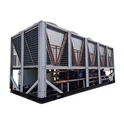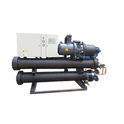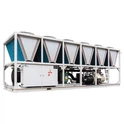The dehumidifier uses a fan to draw moist air into the unit, and through a heat exchanger, the water molecules in the air condense into water droplets. The treated dry air is discharged from the unit. This cycle keeps the indoor humidity at a suitable relative humidity. Industrial dehumidifiers generally heat wet air to advance its ability to absorb moisture. When the equipment heats the wet air through the heater at a constant pressure, the outside world heats the wet air and the temperature of the wet air increases.
"Industrial dehumidifiers do not increase the water vapor content of the wet air, nor do they condense and separate out steam. Therefore, the relative humidity is reduced to reduce it, so the ability to absorb moisture is advanced. It can be seen that the heating process in the heater is a constant proportion humidity process of increasing temperature and enthalpy. When the heated wet air enters the monotone material of the monotone, it is mainly due to the heat release of the wet air (reducing the enthalpy of the wet air) that the moisture guessed by the wet material vaporizes and enters the air,", Increasing the enthalpy of the water vapor in the air can thus be approximated as a constant enthalpy process in which the air temperature gradually decreases and the humidity gradually increases.
The main characteristics of an industrial dehumidifier are: efficient, energy-saving, and fast drying using waste heat recycling, which includes a program intelligent controller, a high temperature insulation box assembly, a low temperature insulation box assembly, an air source heat pump assembly, an air blowing device, and a temperature and humidity sensor. It is characterized in that the high temperature insulation box outlet pipe of the high temperature insulation box assembly is connected to the low temperature insulation box inlet pipe of the low temperature insulation box assembly; The high-temperature dehumidifier uses the waste heat discharged from the existing drying room (box) into the air as a heat source, and uses a heat absorbing coil to absorb the heat in the hot air. Together, the air becomes more and more monotonous. The air with residual heat and the monotonous air is reheated by the heat dissipating coil, causing the temperature to become higher and higher. After reaching the set temperature, the bypass solenoid valve allows the refrigerant to pass through the bypass pipe, and the multi-source heat pump assembly absorbs the heat of the hot air.
Industrial dehumidifiers are specially developed for harsh humid environments. They are not only useful for humidification treatment in industrial factories, workshops, and warehouses, but also can improve the humid environment to achieve desired humidity quickly, eliminate mold that occurs due to humidity, and prevent simple items, materials, and other materials from being affected by moisture, mold, and products with high humidity requirements from being produced, produced, and stored within their required humidity range.
Industrial dehumidifiers are very professional electromechanical equipment, and people lack awareness of them. When selecting dehumidifiers, they often choose a simple model based on the area of the site being dehumidified. Industrial workshops, warehouses, and other air purification equipment that meet technological requirements have strict requirements for humidity. Therefore, dehumidification equipment such as industrial dehumidifiers cannot be selected solely based on the area of the application site.
1. Wood and wood products
Wood is a hygroscopic material that can swell or shorten with changes in its water content, so its water content balance point is not allowed to be changed during processing, which to some extent indicates that it is necessary to control temperature and humidity from the storage of the material to the final processing into a product. The water content equilibrium point of wood at different dry bulb temperatures and relative humidity has different values. It can be used as a basis for determining the environmental conditions required for wood storage and processing.
2. Textiles
In order to produce high-quality textiles at short yarn breaking times and under less defective conditions, it is necessary for industrial dehumidifiers to properly control humidity. Appropriate and stable humidity can reduce static electricity and processing difficulties caused by static electricity, and can also make the conflict between adjacent fibers uniform, achieve more uniform spinning tension in worsted products, and add anti friction properties of warp yarns to enable the equipment to have a higher processing speed. Generally, wool spinning requires higher relative humidity than cotton and synthetic fibers.
3. Paper products
"At any time from the beginning of processing to the end of processing, changes in the moisture content of paper can result in scale changes, and severe bending can invalidate the processing. Therefore, it is important to maintain humidity within a certain range during all processing processes.". Generally, paper with a water content of 5% - 7% has suitable processing strength and functionality, which means that the indoor relative humidity should be 40% - 50%.
4. Photosensitive data
In addition to very high air cleanliness, photosensitive materials require accurate control of temperature and humidity during the production, processing, and storage processes. The occurrence and release of static electricity will leave streaks on the processed film, and static electricity will also adsorb dirt and ridges onto the film. When printing film, especially colorful film, it is necessary to maintain appropriate temperature and humidity in order to align multiple colorful images to produce a clear and vivid image. Industrial dehumidifiers generally store films and cinematographic films in environments and temperatures of 15, 6, and 10 degrees, respectively, with relative humidity of 50% to 40%. The temperature of the printing room is 21.1~26.7 degrees Celsius, and the relative humidity is 40%~50%.
Mar 01, 2023
Characteristics and selection skills of industrial dehumidifiers
Send Inquiry







